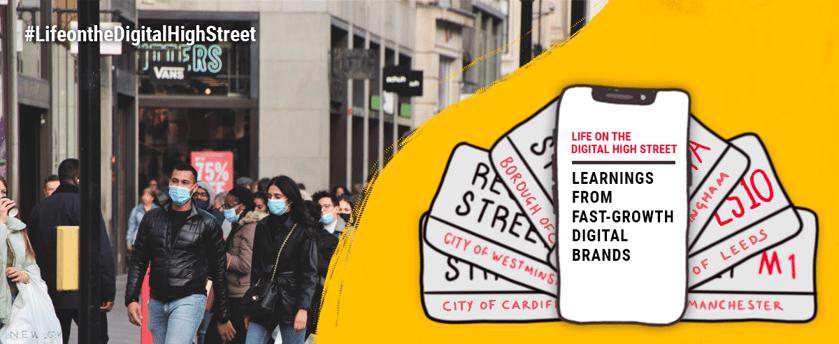Retail Digital Transformation: How To Find Better Customers

A couple of decades ago, a flagship store on a prestigious High Street was the ultimate status symbol for a retail brand. Shoppers would flock to marvel at extravagant window displays and spend whole afternoons browsing what the retail giants had to offer. The way we shop now, online, was a concept on par with humanlike robots and flying cars.
We may not yet have flying cars, but many of the world’s fastest-growing brands are entirely online. This shift in the retail industry highlights the digital transformation that has taken place. Amazon alone clocks up more than 400 million visits every month. In contrast, shoppers reject once-iconic flagship stores, backed by clunky websites, as relics of the past.
What Caused Retail Digital Transformation?
If High Street retailers were steadily jogging along the treadmill of change before the pandemic, Covid cranked it up to an all-out sprint. Andrew Goodacre, CEO at the British Independent Retailers Association, believes we have witnessed “five years’ worth of internet sales growth and five years of high-street decline” in a single year.
Subsequently, High Street stores are now spinning their legs trying to adapt to the new pace of retail digital transformation, knowing a painful fall is inevitable if they can’t.
The Future of the High Street
The High Street may never regain its former status. Instead of a bustling hub of activity, many are now near-deserted, populated by more pigeons than people. Covid has changed more than our shopping habits; it’s completely revamped our lifestyles.
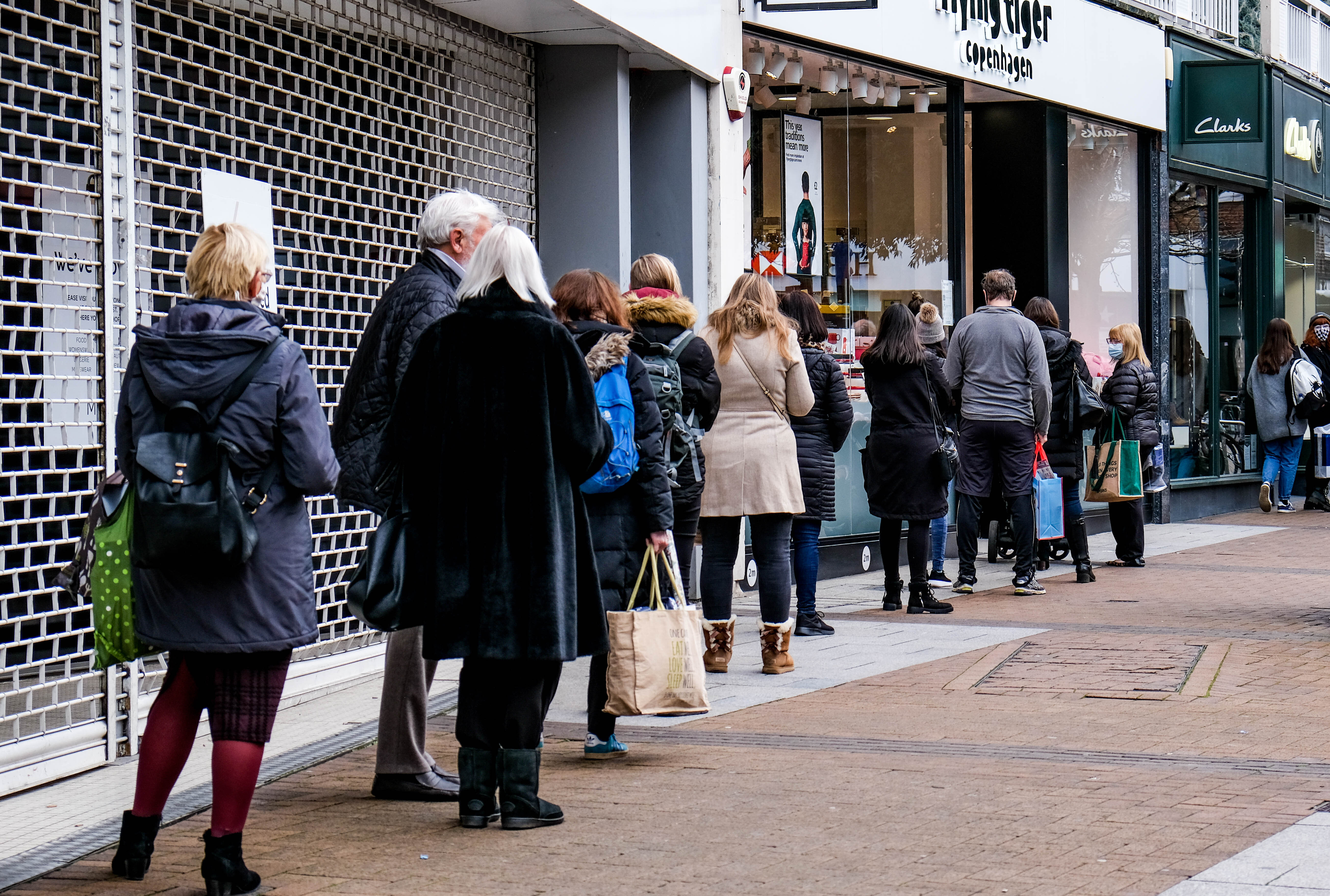
Shoppers queue outside recently reopened High Street stores
Despite the economic hardship Covid caused for many all those years ago, it’s clear consumer appetite remains. The challenge for multichannel retailers and retail businesses now is to capture – and satisfy – this appetite in a way that keeps customers coming back.
To investigate how they might do this, we’ve looked to the online brands rapidly scooping up market share as legacy retailers plan their next move.
Here are 5 ways to kick-start your retail digital transformation, learning from leading digital brands.
1. Improving The Customer Journey
For many marketers, the pandemic eased tight internal restrictions on implementing new technologies and strategies. According to global affiliate marketing network Awin, 57% of retailers claim they had ‘unusual freedom’ to innovate their approaches to customer acquisition last year.
There’s never been a better time to finally implement that referral marketing platform or customer-led growth strategy as part of your retail digital transformation.
Acting quickly is crucial to recovery. Invest in the right resources. Get tools that speak to one another to create slick user experiences and automate processes that free up your teams to focus on the tasks robots can’t.
Modern customer relationship management (CRM) systems are essential for creating personalized customer experiences and integrating them with other tools to enhance customer engagement and operational efficiency.
Don’t be fooled by the queues outside recently reopened brick-and-mortar stores. Pent-up demand from consumers desperate to get out of the house is not the same as sustained demand, which is unlikely to ever match pre-Covid levels.
Consumer behavior has changed for good – adapting to this retail digital transformation is essential to surviving the coming year and beyond.
2. Seamless Multichannel Experiences
Despite what the endless headlines might have you believe, a physical presence on the High Street is often an advantage. If it wasn’t, online retailers like MADE.com and MATCHESFASHION wouldn’t have opened physical spaces, while many others regularly host pop-ups.
These businesses recognise that physical stores provide a powerful touchpoint for engaging target consumers. As well as building brand awareness and affinity that converts into long-term revenue, these spaces generate profit over the short term. Forrester has found 30% to 40% of consumers using click and collect buy additional items once in-store.
While ordering something with a couple of taps on a phone might seem like the ultimate in convenience, this isn’t always the case. There are some products that will always be better tried and bought in person. Perfume, for example, and more considered purchases. Spending thousands on a sofa based purely on photos and reviews, no matter how glowing, feels a risky move.
The danger comes when retailers rely purely on these physical experiences. Not everyone wants to go in-store, especially now it involves masks, one-way systems and queues. Offering alternative options is crucial to keeping customers browsing and buying from you, not your competitors.
Can your customers try on products virtually, like Mister Spex? Can they visit a sister store in person, like Snug Sofa?
And master basic expectations when bridging the gap between on and offline. As anyone who has lugged a bulky online purchase through town only to be told it can’t be returned in-store knows, failing to do so can significantly damage the customer experience.
Once you’ve done this, consider how you can unite on and offline experiences to delight your customers as part of your retail digital transformation. After piloting it in Spanish cities last year, fashion retailer Zara launched in-store mode.
Efficient inventory management plays a crucial role in enhancing operational efficiency and customer satisfaction by streamlining inventory processes and improving stock availability.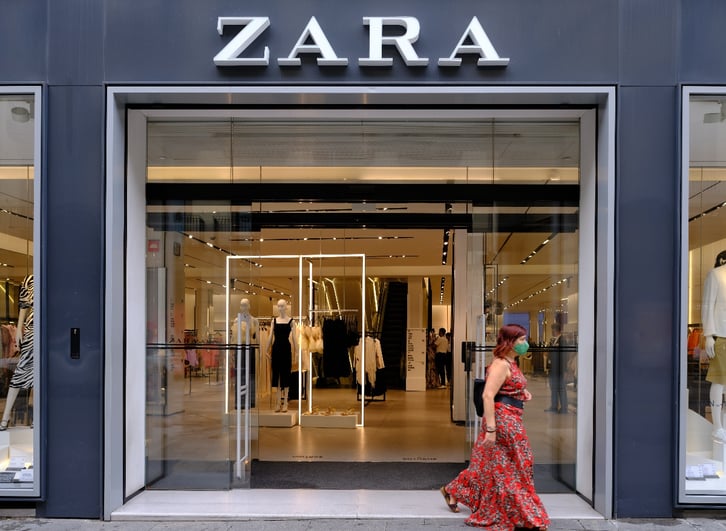
High street retailer Zara has introduced in-store mode for customers
As well as driving repeat purchases, these tools equip you to learn about your customers and tailor their experiences. Zara’s app invites in-store customers to checkout online, meaning the fashion giant can track customer purchases, whether they’re shopping in store or from the comfort of their sofa.
And don’t think the multichannel experience ends once your customer places their order. Physically receiving the order is one of the happiest points in the customer journey. Tap into this by including inserts that surprise and delight, such as handwritten notes or incentives to buy again.
3. Personalization and Customer-Centric Approaches
A truly customer-centric business makes decisions based on customer needs and continuously engages to understand these needs.
Create segments of similar customers and hone in on your target audience. Many High Street retailers are perceived differently by groups of customers. Rather than trying to please everyone, identify your most important target customers and hone in on them.
Why should Barbara, a 55-year-old receptionist from Bromley buy from your ladies’ fashion range? What can you offer her beyond your competitors? How can you make her life better?
Effective segmentation and targeting are as much in what you do as what you don’t do. Focus on Barbara and her walking club friends; forget the 25-year-old high-earning Carl and his drinking buddies.
Data driven decision making helps retailers tailor their offerings and marketing efforts to better meet customer needs. Identify exactly what it is about your business that should attract your target customers, then refine your marketing to effectively target each segment. Rather than, for example, sending out a monthly newsletter to every subscriber promoting the same goods, use dynamic content to promote products most likely to resonate with shoppers based on previous purchases.
When it comes to retail digital transformation, make it feel personal, whether that shopper is online or in-store (or both).
4. Continuous Adaptation and Experimentation
The success of digital-first brands is their agility – a strength that became particularly prominent when lockdown hit back in 2020. Almost right away, these examples of brand advocacy programs connected with their customers to find out what they wanted, then doubled down to fulfill those wants.
Digital technology facilitates the capture and analysis of customer data, leading to better insights and decision-making.
Fast forward to 2024, look at Grind, a London coffee shop that pivoted to offer online coffee subscriptions, complete with compostable, millennial pink packaging.
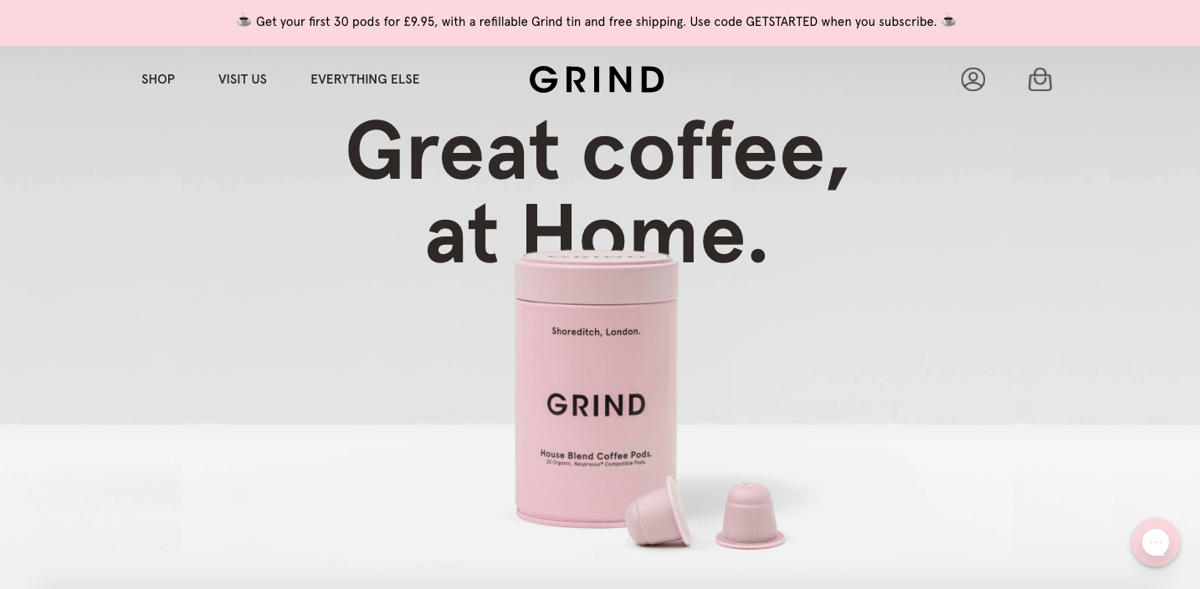
Coffee shop chain Grind now sells products online
Long-term strategy planning undoubtedly has its place, but it can’t underpin every campaign. Don’t be afraid to test quick and dirty tactics, such as time-limited incentives or one-off product bundles. Invest with minimal overheads, so you have little to lose if the risk doesn’t pay off.
Consumer behaviour will continue to change, which is a key part of retail digital transformation. And their expectations are even higher. If 30 year old Kate can enjoy a Michelin-starred meal twenty minutes after ordering it from her bed, why should she wait 5 to 7 working days and pay for the delivery of a t-shirt?
Like a scientist in the lab searching for the latest magic pill, experiment. Keep trying new approaches with your customers. Not every one will be a success; that’s okay. Learn from them and try again. You’ll be amazed by how much you’ve learnt and achieved when you look back at the end of the year.
It might feel risky but in reality, the biggest risk of all is doing nothing. Wait too long to implement that new strategy, and your online competitors may well have backed you into a corner beyond recovery.
5. Building a Community
Human connection is one of the most powerful influences on our behaviour. Tap into this by turning your customers into a community. One rooted in living and proudly sharing your brand purpose with the rest of the world.
Not every member of your community will buy from you, and not everyone who buys from you will be part of your community. That doesn’t matter. What does matter is you’re nurturing a group of people who care about your business beyond what you’re selling. If they haven’t bought it yet, there’s a strong chance they will one day.
Virtual reality (VR) technologies can enhance online shopping experiences by allowing customers to virtually try on clothing or visualize products in their own environments, driving significant sales growth through immersive experiences.
Sweaty Betty is a great example of a brand getting this right. As well as selling high-quality products, the British retailer offers workout sessions, wellness tips, motivational stories, nourishing recipes and more, all underpinned by its mission to empower women. 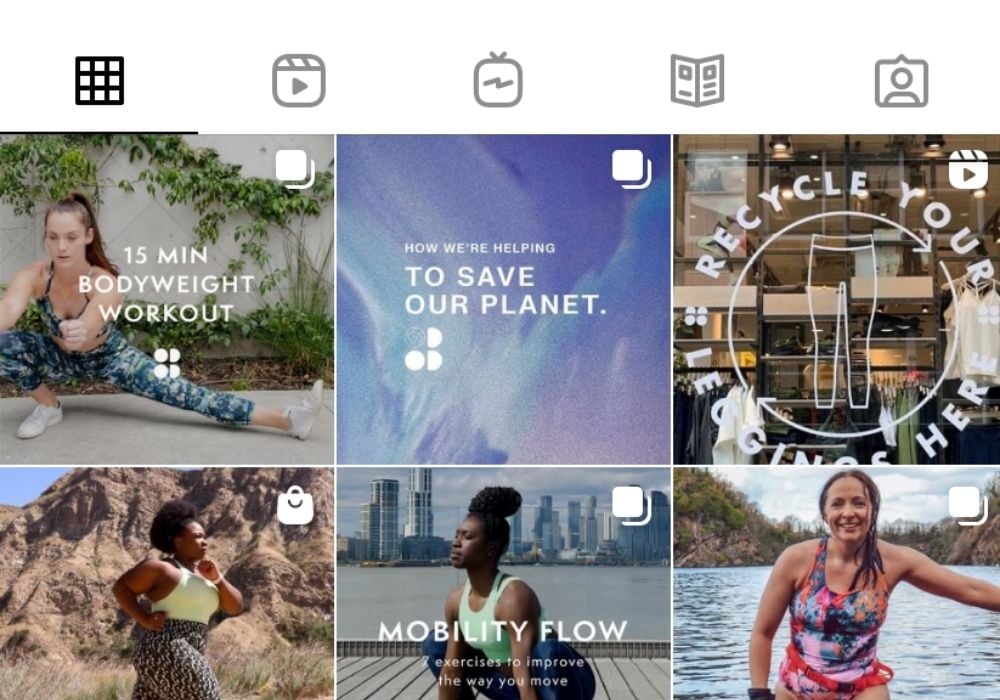
Sweaty Betty’s Instagram grid reflects its mission to empower women
Everything Sweaty Betty does is rooted in its community. In the words of Matilda Egere-Cooper, its Head of Content and Social: “It’s about listening to what they’ve got to say, sharing their stories, and showing that we care”. It’s an approach that’s obviously working: as of 2024, the British retailer currently counts more than 719,000 followers on Instagram.
Think about how you can bring your community to life on and offline. Promote your values with unmissable posters in-store; invite customers to real-life meet-ups and group events; bring your values to life in your actions, such as H&M promoting sustainability through its clothes recycling bins.
Your best marketer isn’t the person sat beavering away at their laptop. It isn’t the person giving the impressive presentation at your company meeting. Your company’s best marketers are – or, rather, should be – your customers.
51% of consumers trust a recommendation from their friend more than any other advertising. Offer products and services your customers love, and they’ll tell others about it. People who will listen and may well become customers themselves.
The High Street isn't dead — it's different
As the collapse of the once iconic Topshop shows, an established physical presence is no longer enough to guarantee your place on the digital High Street.
In 2021, shops are more than somewhere to try on clothes and complete transactions. They’re experiential spaces where consumers can connect with brands that share their values and beliefs. And they’re centred on the customer. This is retail on customer terms: experiences rooted in functionality, use and value.
Rather than see digital and physical channels as competing, take advantage of having both. Bridge the gap to create seamless customer experiences that stand out. Integrating advanced systems and technologies into your retail operations can significantly enhance efficiency and customer satisfaction. Experiment with how to attract your target customers, constantly testing and learning what gets their attention.
In the words of Justin Pearse, editor of Ecommerce Age, : ‘Don’t stop. Don’t stop the move to providing a fully integrated experience across all your channels. Make sure your brand is seamless and frictionless across every channel. Give every customer an amazing experience, no matter where they are”.
The High Street isn’t dead — it’s different. The businesses that embrace this retail digital transformation will thrive.
FAQ
What is Digital Transformation in Retail
Digital transformation in retail refers to the comprehensive integration of digital technologies into every facet of the retail business. This transformation encompasses customer engagement, operational efficiency, and supply chain management. By leveraging cutting-edge digital technologies such as artificial intelligence (AI), augmented reality (AR), and data analytics, retailers can significantly enhance the customer experience, streamline operations, and drive business growth.
At its core, digital transformation in retail aims to create a seamless omnichannel shopping experience. This means that whether customers are shopping in-store or online, they encounter consistent pricing, product selection, and information.
For instance, AR can allow customers to virtually try on products, while AI can personalize shopping experiences based on individual preferences. Data analytics, on the other hand, provides valuable insights into customer behaviour, enabling retailers to make informed decisions that boost customer satisfaction and loyalty.
In essence, digital transformation in retail is about embracing digital technologies to stay competitive and meet the evolving needs of today’s tech-savvy consumers.
How to Use Customer Data for Insights?
Customer data and analytics for insights
Customer data is a goldmine for retailers, offering a wealth of information about customer behavior, preferences, and purchasing habits. By effectively leveraging customer data and analytics, retailers can gain a deeper understanding of their customers, allowing them to develop targeted marketing strategies that drive sales and enhance customer satisfaction.
Data can be collected through various channels, including mobile apps, social media, and loyalty programs. For example, a retailer might use a mobile app to track a customer’s purchase history and browsing patterns. By analyzing this data with advanced data analytics tools, retailers can uncover valuable insights, such as which products are most popular among certain demographics or what times of year certain items are in high demand. This data-driven approach enables retailers to tailor their offerings and marketing efforts to better meet the needs of their customers.
Market research and trend analysis
Market research and trend analysis are pivotal components of digital transformation in retail. By staying attuned to market trends and customer behavior, retailers can identify opportunities to enhance their products, services, and overall customer experience.
Market research can be conducted through various methods, including surveys, focus groups, and social media listening. For instance, a retailer might use social media listening tools to monitor customer conversations and identify emerging trends. Trend analysis involves examining data to detect patterns in customer behavior, such as shifts in purchasing habits or evolving preferences. By understanding these trends, retailers can proactively adapt their strategies to stay ahead of the competition and meet the changing demands of their customers.
Data capture and smart data capture
Data capture and smart data capture are critical elements of digital transformation in retail. Data capture involves collecting information from various sources, including customer interactions, transactions, and social media. This data provides a comprehensive view of customer behavior and preferences.
Smart data capture takes this a step further by using technologies such as artificial intelligence and machine learning to analyze and interpret data in real-time. For example, AI can analyze customer interactions on a website to identify patterns and predict future behavior. This real-time insight allows retailers to make data-driven decisions that enhance the customer experience and drive sales. By leveraging smart data capture, retailers can stay agile and responsive to customer needs, ensuring they remain competitive in a rapidly evolving market.
In conclusion, leveraging customer data for insights is a cornerstone of digital transformation in retail. By understanding and acting on customer data, retailers can create personalized experiences, anticipate market trends, and make informed decisions that drive business success.

Dan Barraclough
Read more >
Never miss another update
Subscribe to our blog and get monthly emails packed full of the latest marketing trends and tips



